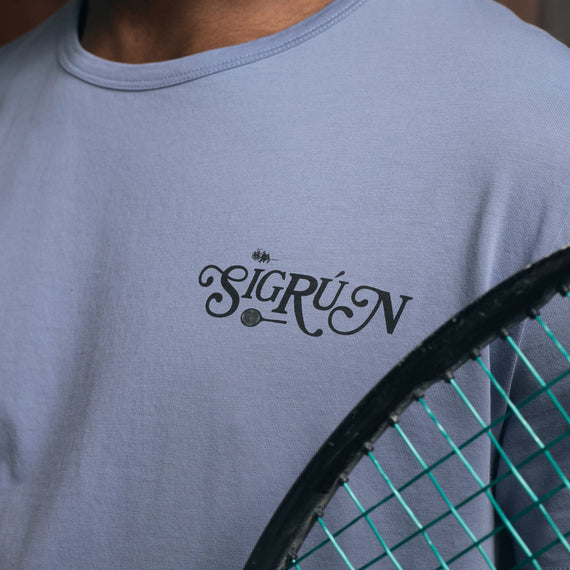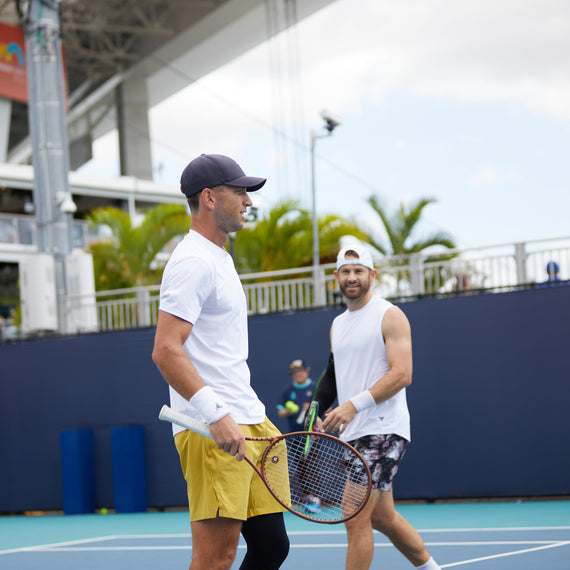We are committed to producing premium quality performance and lifestyle apparel more sustainably, so you don't have to worry about the choices you make when you shop with us. Learn more below about our material, production, packaging and end-of-life initiatives.
Material
100% of 2024 fabric content is responsibly sourced(1)
88% of 2024 synthetic fabric content is recycled
Products with at least 50% sustainable (recycled or organic) fabric content are denoted by the green leaf icon(2) to help you make better purchase decisions

Our fabric content
Fabrics make up substantially all of the materials that go into our products and over 99% of our fabrics are certified recycled, organic or responsibly sourced. Our fabrics are made by high quality fabric mills from around the world using globally recognized, certified and premium fiber brands such as SUPIMA® cotton, ECONYL® regenerated nylon and Q-NOVA® regenerated nylon. By purchasing products using better materials (such as recycled or organic fibers), you are improving their value, increasing the incentive to recycle or buy organic and improving the supply chain for these materials, contributing to an overall more circular and better product lifecycle. Learn more about the fabric contents that go into our products below, and review the product material contents on our product pages for more information about specific products.

Recycled polyester
We use GRS® certified recycled polyester yarns made from post-consumer waste, such as recycled plastic bottles. Using these materials reduces the impact of virgin synthetic material production on the environment by using less raw material (e.g., no petroleum) and less energy while reducing landfill and ocean waste.

Regenerated nylon
We use GRS® certified ECONYL® and Q-NOVA® regenerated nylon yarns. ECONYL® regenerated nylon is made entirely from recovered nylon waste, such as nylon fabric scraps, carpet fluff, fishing nets and pre-consumer industrial and plastic waste. Regenerated nylon can also be continuously recycled to produce new products with the same quality as virgin nylon.

Responsibly Sourced Cotton
We use responsible cotton grown in the U.S. (such as premium SUPIMA® extra-long staple cotton) and Australia by farms and growers that are part of the Cotton LEADS® program. SUPIMA® and Cotton LEADS® promote better cotton production by providing transparency and standards that reduce water, fertilizer and pesticide use; lower energy consumption; preserve land and enhance biodiversity when compared to other conventionally grown cottons. Our cotton is natural, biodegradable and traceable, ensuring it is produced responsibly.

Organic Cotton
We use organic cotton certified by GOTS®, a globally recognized certification organization and standard, that the fabric is made from a minimum of 95% organic cotton fibers. Organic fibers are natural fibers grown without the use of synthetic pesticides or herbicides and GMOs that sustains the health of ecosystems, soil and people. GOTS certification also requires adherence to stringent standards on environmental and social, such as worker safety, criteria at all stages of production and ensures transparency back to the farm.
Fabric technologies
We also use fabric technologies like ionic+®, an embedded silver-ion anti-bacterial technology that inhibits the growth of bacteria on fabrics, Polygiene® BioStatic, a natural silver-salt anti-odor application, and brrrº, a fabric knitting technology that provides a superior cooling effect on the skin with wicking and quick dry properties, that improve the longevity and performance of our products. Clothes made with ionic+® and Polygiene® will continue to smell fresh match after match, and need fewer washes in between, and clothes made with brrrº will help improve your performance on the hottest days. Read our product details to look for products made using ionic+®, Polygiene® and brrrº.

Production
All of our apparel fabric is produced in mills certified by OEKO-TEX® S100 and most is produced by mills approved by bluesign® helping us ensure our production is done responsibly, with safe chemistry, better resource use and minimal impact on people and the environment
Certifications such as OEKO-TEX® S100 and bluesign® approval help us ensure our production is done responsibly, with safe chemistry (i.e., no harmful substances), better resource use and minimal impact on people and the environment. In addition to certifications on many of our fabrics, we are working with our factories to move towards full product certification, meaning that in addition to the fabrics, we plan to move all of our trims, printing and washes (such as enzyme and rinse washes) to certified vendors.
We also focus on ensuring our production process is transparent so we know where are products and raw materials are coming from, such as which farms and regions our cotton is from (e.g., the U.S. and Australia). Our fabrics are also made using processes such as cationic dyed fabric that reduce the water, energy and chemicals required and improve dye efficiency(4).
In addition to the environmental goals we support, we also support better labor practices. Many of the certifications, such as OEKO-TEX® S100 and bluesign® also check that the farms and raw materials, spinners, mills and factories are adhering to international labor standards. We've carefully chosen our supply chain to ensure that our partners adhere to fair worker treatment and wage laws.
Packaging
100% of our packaging (excluding our compostable polybag) is made from recycled materials and most of that is FSC certified recycled
100% of our packaging (excluding our compostable polybag) can be recycled in normal paper recycling
Compostable polybags degrade in landfills significantly faster than standard polybags, which are challenging for consumers to recycle in more places

We've designed our packaging to reduce the volume of material used and for the material that is used, ensure that it is made from recycled material and can easily be recycled or disposed of by our consumers. We believe recycling should be easy and are working on making our packaging so that it's easy for our consumers to take the responsible action.
All of the packaging you receive will be recyclable in your normal paper recycling or compostable(5). All of our mailers and interior packing materials (inserts, tissue paper, stickers and wrapping tape) are made from recycled material, fully recyclable in paper recycling and compostable. Even the ink is plant-based.
We have two polybags in circulation, which are home compostable and made from corn starch, PLA and PBAT. For the vast majority of consumers who will otherwise end up throwing these away, they will decompose faster than normal plastic. Our home compostable polybags can be home composted in less than 6 months and use 65% less energy than conventional plastic to make. We continue to evaluate better ways to protect our products during transport that reduce the use of plastic while maintaining the quality of our products.
Circularity for end of life
Re-use and recycle incentive program that promotes donating or recycling used athletic wear and keeps synthetic clothing out of landfills
2ndServ is our end of life donation and recycling program that incentivizes customers to send us their used athletic wear so that it can be donated or recycled and turned into a new product. While we are doing what we can to produce more sustainably, ultimately a large part of improving the lifecycle of garment production falls to its end of life - consumer behavior. 2ndServ is meant to help change consumer behavior and encourage better re-use and recycling habits. Habits that will ultimately provide valuable raw materials that can often be recycled into new fibers for textile production. 2ndServ is a limited test and is part of our initiative to continuously evaluate and test new ways to sustainably re-use, recycle and dispose of our clothes.

Read more
Learn more about what we're doing and where we are at with our own sustainability goals and explore ways to play tennis more sustainability at the Journal
Explore more
Explore our collections. All of our collections are responsibly sourced, but we have also included the green leaf to help you identify products made primarily with recycled or organic content
Notes
Data updated as of April 4, 2024 including all production runs through 2024. Fabric content stats exclude accessories and are calculated based on utilized fabric weight. Packaging stats are based on purchase orders.
- We define "responsibly sourced" as fabrics that are certified by OEKO-TEX®, bluesign® approved and/or confirmed responsible, such as cottons made under the Cotton LEADS® program. These fabrics are made adhering to strict environmental and labor guidelines and use materials that are natural or synthetic and made under processes that reduce the water, energy and chemical requirements vs. traditional manufacturing and growing techniques. The majority of our fabric that is not recycled or organic is our responsibly sourced cotton
- Why haven't we labeled Cotton LEADS® cotton with our green leaf? We believe there is a real distinction between the benefits of organic cotton and even responsibly grown U.S. or Australian cotton(2). Our U.S. and Australian cotton is natural and responsibly made (and in many cases more sustainable than synthetic fabrics), but we want to be transparent on how we communicate our sustainability. Organic cottons forgo toxic chemical use and GMOs, using 91% less water and 62% less energy than conventional cotton and promoting biodiversity and reducing land and water pollution (http://aboutorganiccotton.org/). We believe natural materials like cotton that are traceable and made at high quality, certified farms that use processes aimed to reduce the impact of cotton production still provide a more sustainable solution than synthetic materials for most uses
- In addition to the benefits listed, many of our materials and garments can be continuously recycled (with some limitations based on the blend and recycling facilities)
- Cationic dyed cotton benefits include almost 100% dye utilization, reducing wastewater, dye time and energy use and requiring less dye and no salt or alkali
- Only the string (which is made from recycled cotton) and the nickel-free safety pin that attach the hangtag to our clothing can't be recycled through normal paper recycling











